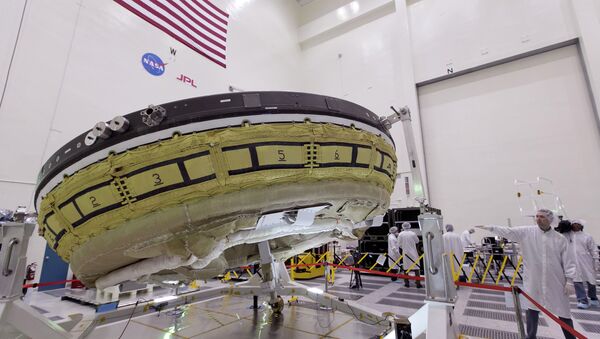It’s called the Low-Density Supersonic Decelerator (LDSD) and its purpose is to allow NASA scientists to land heavier payloads on the Red Planet.
— NASA (@NASA) June 8, 2015
The saucer-shaped 7,000 pound vehicle is equipped with a massive balloon to aid the launch, and a doughnut-shaped cushion and parachute, designed to slow the spacecraft down as it descends in the Martian atmosphere.
Following a week of delays due to weather conditions, the test began on Monday at 1:45 PM EST, with the vehicle being launched from the US Navy’s Pacific Range Facility on the Hawaiian island of Kauai. According to NASA scientists, Monday was the first day the ocean and wind conditions were suitable for the test launch.
— NASA (@NASA) June 8, 2015
— NASA (@NASA) June 8, 2015
The test saw the saucer being lifted up to a height of 120,000 feet by the balloon. The flying saucer was then released, as a booster launched it up to an even higher altitude of 180,000 feet at a speed of Mach 4 – four times the speed of sound.
— Bobak Ferdowsi (@tweetsoutloud) June 8, 2015
According to NASA scientists, the air above the Pacific Ocean serves as a suitable substitute for the Red Planet’s atmosphere, and the test used "the very thin air found high Earth’s atmosphere as a 'local' test space that duplicates many important aspects of Mars’ low-density atmosphere."
After it reached the target altitude, a doughnut-shaped cushion, known as the Supersonic Inflatable Aerodynamic Decelerator (SIAD), inflated to a diameter of 20 feet in order to slow down the spacecraft’s descent to about Mach 2.4. The true test for the technology, however, was the ability of the newly designed parachute to slow the saucer down even more, with the goal of helping it land gently on Earth's Pacific Ocean. According to NASA, the parachute failed to do so.
"This test is centered on how our newly designed supersonic parachute will perform," Mark Adler, Project Manager of NASA’s Jet Propulsion Laboratory said. "What we will be looking most closely for is to see what happens when at Mach 2.35 out supersonic parachute is deployed."
Called the Supersonic Ringsail, the current parachute was the largest one ever used and was designed as an improvement to the former model, which tore apart during the spacecraft's landing, sending it splashing down on the ocean's surface.
— NASA Technology (@NASA_Technology) June 6, 2015
Despite its large size, however, the Supersonic Ringsail, which measures 100 feet across once deployed, was unable to lead to a safe and gentle landing. NASA spokeswoman said in an email that while it was successfully deployed, the parachute failed to inflate.
The space agency has released no additional information on the test, with plans to release more details in a news conference on Tuesday.


